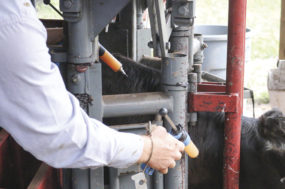I was born and raised in St. Charles, a rural town in southeastern Idaho. No, my parents didn’t run a potato farm, although the size of our potato garden might lead you to believe so. Rather, we ran a small cattle ranch.
Located in the popular Bear Lake valley, I spent my youth slaving away in the sun while I watched tourists and vacationers having fun in the sun and on the lake. I wished to be one of them.
Of course, they all would leave when the snow was deep and temperatures reached minus 20ºF, but farm work was faithful and never left. I decided in my teens that I would choose a different path, which brings me to the present life of a CPA.
However, since my rebellious teenage mentality, my father’s prodigal son has returned, and I now thrive in helping run the farm operations. Farming is my idea of therapy. So now I say, “Play on, vacationers; I think I’ll stay right here in the saddle.”
On to tax matters. Now a distant memory, it was just a few months ago the U.S. was headed toward the fiscal cliff. You might have experienced just how hard it was to do any tax planning at the end of 2012 due to the uncertainty of the tax landscape for 2013.
I know it was a frustration for me and my clients. Just when it appeared no deal would be reached, and we began to brace ourselves for the worst, Congress worked together to avert the fiscal cliff by passing the American Taxpayer Relief Act of 2012. The act is voluminous, so I’ll only attempt to cover some of the highlights.
Depreciation
The American Taxpayer Relief Act of 2012 (the act) extended some favorable depreciation treatments. In 2012 additional first-year depreciation (better known as bonus depreciation) allowed a 50 percent deduction on the cost of certain qualifying fixed assets purchased in that year.
This deduction was scheduled to expire in 2013. However, the act extended the 50 percent first-year bonus depreciation for qualifying property placed in service before January 1, 2014. As a general rule, a fixed asset meets the qualifying property test if its original use begins with the taxpayer (it is new, not used) and it has a MACRS recovery period of no more than 20 years.
Generally speaking, assets used for farming have a recovery period of 20 years or less, and therefore qualify for bonus depreciation as long as they are purchased new.
Also extended through 2013 are the favorable maximum depreciation caps on qualifying vehicles. Before the act, first-year depreciation on passenger autos and light trucks and vans (loaded GVW of 6,000 pounds or less) would have been capped at $3,160 and $3,360, respectively.
As in 2012, the act boosted that first-year cap by $8,000 for 2013. A passenger auto or light truck generally qualifies for the additional $8,000 first-year depreciation if it is purchased new.
Heavy vehicles (loaded GVW of more than 6,000 pounds) are not limited to the $8,000 of additional depreciation, but rather qualify for the full 50 percent first-year bonus depreciation as long as they are also purchased new.
The act also enhanced the Section 179 expense deduction for qualifying property. Under the Section 179 expense rules, a taxpayer can choose to expense, rather than depreciate, any amount up to the entire cost of new or used tangible property in the year it is placed in service.
Before the act, the maximum Section 179 expense deduction in 2013 would have been $25,000 with a dollar-for-dollar reduction if Section 179-eligible property placed in service during 2013 was more than $200,000.
The maximum Section 179 expense deduction was boosted to $500,000 with a dollar-for-dollar reduction if Section 179-eligible property placed in service during 2013 is more than $2,000,000. Certain limitations do apply for vehicles.
Tax rates
Before the act, the Bush-era individual tax rates of 10 percent, 15 percent, 25 percent, 28 percent, 33 percent and 35 percent were scheduled to expire and the tax rates would have risen to 15 percent, 28 percent, 31 percent, 36 percent and 39.6 percent starting in 2013.
However, under the act, the Bush-era tax rates were made permanent for 2013 and all future years except for taxpayers with taxable income of $400,000 ($450,000 for married taxpayers), who are now subject to a 39.6 percent tax rate on taxable income in excess of these amounts.
Capital gains
In the past, long-term capital gains (meaning gains on capital assets held longer than one year) and qualified dividends have had favorable tax rates of 0 percent for taxpayers in the 10 percent and 15 percent tax brackets and 15 percent for all other taxpayers.
These rates were scheduled to increase in 2013. However, the passage of the act continued the 0 percent and 15 percent tax rates. A 20 percent tax rate was also added for taxpayers with taxable income of $400,000 ($450,000 for married taxpayers).
One caveat, however, is that starting in 2013, there is an additional 3.8 percent Medicare surtax under the Patient Protection and Affordable Care Act, also known as Obamacare, on some capital gains (short term or long term), as well as other items of investment income.
This tax applies to taxpayers with modified adjusted gross income of $200,000 ($250,000 for married taxpayers).
Examples of farming capital assets that could potentially produce a capital gain or loss when sold are fixed assets; livestock held for draft, breeding or dairying; and animals not held primarily for sale. In addition, these items are not subject to the 3.8 percent Medicare tax since they are business assets.
Social Security tax
In 2011 and 2012, there was a 2 percent tax cut on the portion of the Social Security tax paid by an employee. This affected taxpayers, including most farmers, with self-employment income since they pay both the employee and employer portions of payroll taxes.
This payroll tax cut was not extended in the act. Therefore, in 2013 the Social Security tax paid by employees has gone back up from 4.2 percent to 6.2 percent and self-employment tax has gone back up from 13.3 percent to 15.3 percent.
Estate tax
Before the act, the maximum estate tax rate was scheduled to increase from 35 percent in 2012 to 55 percent in 2013, and the exclusion amount was scheduled to decrease from $5 million to $1 million.
Fortunately, starting in 2013, the act made permanent a maximum federal estate tax rate of 40 percent and a $5 million exclusion adjusted annually for inflation.
Conclusion
As indicated in its title, the American Taxpayer Relief Act truly offers relief to the American taxpayer, including farmers. Careful planning can help to maximize tax savings and avoid missed opportunities and pitfalls.
While some of the provisions in the act have been made permanent going forward, others are scheduled to expire at the end of 2013. Although many of these important highlights have been discussed here, it is important to partner with your tax adviser to fully understand the tax benefits available to you.






